|
The Year That Was 2010, Part One
Similar to our previous Nexus Graphica best of the year columns, the selections showcase the difference
between Mark's tastes and mine. Of the twenty titles chosen, ten by each of us, only two titles made
both of our lists. For comparison purposes, we shared three books last year and two in 2008. Vive la différence!
I am hosting the first (or last... depending on your perspective) five selections
with Mark returning in two weeks to announce titles 5 through 1.
Without further adieu, I present numbers 10 through 6 of the annual Nexus Graphica recap.

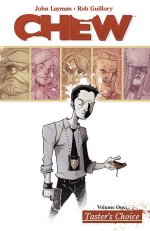 10.
(Rick)
Chew Omnivore Edition, Volume 1 by John Layman (script) and Rob Guillory (art) (Image)
10.
(Rick)
Chew Omnivore Edition, Volume 1 by John Layman (script) and Rob Guillory (art) (Image)
Layman and Guillory create an alternate present where, due to avian flu fears, the
American government has criminalized the possession, sale, and consumption of all
poultry! Tony Chu, investigator for the Special Crimes Division of the powerful FDA,
employs his abilities as a cibopathic -- he gets psychic impressions from whatever
he eats -- to solve crimes. Guillory's over-the-top humorous illustrations and
Layman's clever script expertly mix to spawn an enjoyable concoction of cannibalism,
conspiracy, and murder. This luscious hardcover collects issues 1-10 (Volumes 1
and 2 of the trade paperback collections), complete with character design and sketches.
(Mark)
Chew Volume One: Taster's Choice by John Layman (script) and Rob Guillory (art) (Image)
Here's one I wouldn't have seen if Rick hadn't sent me his copy -- replete with his
instructions to "read this!" The homophonically-titled (and punning) title follows
the very mis-adventures of Tony Chu, investigator for the Special Crimes Division
of the FDA, which has become a bloated, DHS-like agency in the wake of an avian flu
outbreak, which lives the raising, selling -- and chewing -- chickens as a high crime
indeed. Guillory's near-caricature art fits the script, which dances perilously close
to caricature itself, but so pulls back from the edge to make some
trenchant -- chewy? -- points about the state of high crimes and misdemeanors
when the surveillance is non-stop. Even a mealtime.
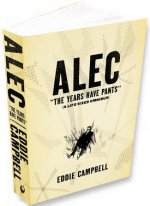
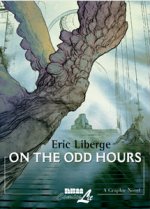 9.
(Rick)
Alec: The Years Have No Pants by Eddie Campbell (Top Shelf)
9.
(Rick)
Alec: The Years Have No Pants by Eddie Campbell (Top Shelf)
Probably best known for his collaboration with Alan Moore on the extraordinary
From Hell, Eddie Campbell, serving as both writer and artist, first gained
acclaim for Alec, the thinly-veiled autobiographical adventures of a
Scottish artist. Alec :The Years Have No Pants collects all of the very frank,
often humorous previously published tales plus a new story. While all the stories showcase
Campbell's distinctive art, the highlight of this impressive book derives from the
evolution of the artist. Midway through the 638 page volume, the realization dawns
that Eddie Campbell may be one of the field's most accomplished storytellers.
(Mark)
The Odd Hours by Eric Liberge (NBM)
Night at the Museum for grown-ups, especially since that Museum happens to be
the Louvre. Liberge's story involves a deaf mute (Liberge smartly draws his signing by
showing multiple hand motions -- with "voice" balloons" -- within the panels) who is
hired -- or anointed -- for a very special "night watch," wherein the works of art
come alive and need to be "fed." Not in a horror-flick way, but rather, by music (the
beating of a certain drum), as the "soul" invested in each great work needs to be
nourished. Chaos eventually ensues, and a sequence where the hero Bastien has
Pagliacci-like make-up on his face, while drumming the artworks alive make you
realize all over again why you like comics so much. And though the book ends too
suddenly, with much left unresolved, the fact that this is part of a series co-sponsored
by the Louvre is itself surprising, since the institution doesn't always come off
looking good, in terms of bureaucratic behavior. Hard to imagine someone in charge
of public relations, for a similar institution here, allowing such a project to get off the ground.
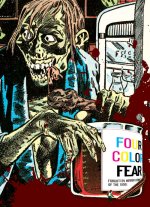
 8.
(Rick)
Four Color Fear: Forgotten Horror Comics of the 1950s Edited by Greg Sadowski (Fantagraphics)
8.
(Rick)
Four Color Fear: Forgotten Horror Comics of the 1950s Edited by Greg Sadowski (Fantagraphics)
With contributions by Jack Cole, Reed Crandall, George Evans, Frank Frazetta, Jack
Katz, Al Williamson, Basil Wolverton, and Wallace Wood, the 300+ page, full
color Four Color Fear offers some of the finest pre-code comic book horror tales ever
produced. Extensively researched, complete with story notes, editor Sadowski compiled a
superior collection of non-EC tales, many of which rarely reprinted and even more rarely
in color. A 30-page cover art section and a fascinating article by historian John
Benson, who also supplied the book's intro, about the little remembered, but
prolific Ruth Roche, round out one this sensational historical tour of the Golden Age of Horror Comics.
(Mark)
The Playwright by Daren White (words) and Eddie Campbell (art) (Top Shelf)
A rumination on loss, and the over-compensations of seeming fame. White writes in
documentary fashion about a successful British playwright, who -- like, say David
Hare or the late Harold Pinter -- moves fluidly between stage, TV, and film
projects. He also lives a lonely life as he rides buses to his appointments (lunch
with agents, etc.), while fantasizing about the breasts of female passengers -- or
said passengers in entire states of undress and throes of passion -- and
ruminating on lost loves. The rectangular comic is structured in "voice over"
format -- narrative panels describing inner landscapes, but the characters never
speak directly to each other. Which is an interesting choice in a graphic novel
about someone who makes his living writing about characters who speak to each
other. There is much that is bracing about the book, including perhaps, the
combination of loss and redemption at the end. Definitely compelling, and
Campbell does some of his best work here, in a variety of "textures..."
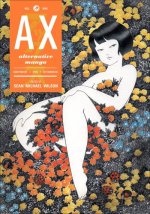
 7.
(Rick)
Ax Volume One: Alternative Manga Edited by Sean Michael Wilson (Top Shelf)
7.
(Rick)
Ax Volume One: Alternative Manga Edited by Sean Michael Wilson (Top Shelf)
Weighing in at 400 pages, Ax reprints for the first time in English some
of the finest selections from Japan's legendary alternative comics
magazine Ax. Much like their American alternative counterparts, the
often experimental stories center around sexual, scatological, and surrealistic
elements within a wide range of artistic styles and a great variance in
quality. Highlights include Takao Kawasaki's tale of a terminally ill
hitman "Rooftop Elegy"; "Inside the Gourd," a delightful magic realistic love story
by Ayuko Akiyama; a disturbing vision of relationship end in "Push Pin Woman" by
Katsuo Kawai; Toranusuke Shimada's fantastic "Secret Story Tour #1: Enrique Kobayashi's
Eldorado," an alternative history of motorcycles, Nazis, and capitalism; Yoshida
Mitsuhiko's excellent cartooning and storytelling skills overcome the fact that
his "The Hare & the Tortoise" almost perfectly mimics the classic Tex Avery Bugs
Bunny cartoon "Tortoise Beats Hare" (1941); and Shigeyuki Fujumitsu's powerful
tale of redemption, respect, and aging, "The Song of Mr. H." Overall an excellent
collection of tales, Ax serves as the perfect American introduction to the largely
unfamiliar universe of manga not dominated by wide-eyed characters and wanton violence.
(Mark)
American Vampire Volume 1 by Scott Snyder and Stephen King (writers) and Rafael Albuquerque (art) (Vertigo)
I hadn't caught up with this Vertigo title until its recent five-issue collection
from Vertigo. Those a bit weary of "lovelorn Southern gentlemen, anorexic teenage
girls (and) boy-toys with big dewy eyes" in their vampire books (and shows) might
enjoy this parallel tale set in both the Old West and silent-movie era Los Angeles,
as Snyder (with a scripting assist from King in the "western" parts) seek to create
a uniquely "American" take on the vampire. Which they do in the form of gunslinger
Skinner Sweet, who -- in finest American fashion -- is both bloodthirsty and psychotic,
in both living an undead incarnations. And hey, the Hollywood parts -- with its tales
of "B-girls gone bad" -- almost get you thinking that Nathanael West must've written
a vampire tale right before he tackled Day of the Locust. The traffic in the
denouement(s) gets a tad cluttered, but it's a compelling ride all the way through,
leaving you with a nice set-up for the next arc (and the next American decade in the cycle!)
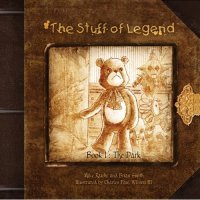
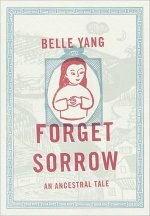 6.
(Rick)
The Stuff of Legend Book 1: The Dark Written by Mike Raicht & Brian Smith Art by Charles Paul Wilson III (Villard)
6.
(Rick)
The Stuff of Legend Book 1: The Dark Written by Mike Raicht & Brian Smith Art by Charles Paul Wilson III (Villard)
After the Boogeyman kidnaps a young boy, his toys mobilize to save their beloved
master. The metallic Colonel leads Maxwell the teddy bear, Percy the piggy bank, the
wooden duck Quackers, the Native American Princess, Jester from the jack-in-box, the
angel Harmony, and the real puppy Scout into the feared closet. Upon entering the
Boogeyman's domain, toys shake their artificiality and become the things they represent
(Maxwell an actual bear, Quackers a real duck, Princess a flesh and blood Indian,
etc.) In an amazing cross-pollination of Toy Story and Wizard of Oz,
Raicht, Smith, and Wilson introduce a fascinating land inhabited by forgotten toys
and fueled by the forces of evil. Newcomer Wilson's lush work ideally supports this
imaginative triumph.
(Mark)
Forget Sorrow: An Ancestral Tale by Belle Yang (Norton)
At first glance, this volume wouldn't appear to represent any particularly new turf for
the graphic novel, representing as it does the crossover of a renowned children's artist
into comic panel territory, in order to tackle a memoir. But just as traditional book
publishing did -- and does -- sustain a model for many different kinds of non-fiction
remembrances and witnessing, so too in graphic novel land is there always room for any
engaging retelling of histories, human sorrows and consequence. Here, the Carmel-based
Yang uses her own story: a young daughter phased by college and by a psychotic, stalking
Ex, retreats to her family home where her parents -- her father especially -- regard with
some scorn for the mired state of her life. It's in getting her father to open up about
his own travails -- born in China, eventual escape to America and those of his family
(and hers) heading into the 20th century, with its King Lear-like twists. Coming,
as it does, so many years after the not dissimilar Maus (or Persepolis)
the type of story may not be a surprise in comics form, but this is engaging and
large-hearted enough to make you look forward to Yang's next project.
Copyright © 2010 Rick Klaw and Mark London Williams
Professional reviewer, geek maven, and optimistic curmudgeon, Rick Klaw has supplied
countless reviews, essays, and fiction for a variety of publications
including
The Austin Chronicle,
The San Antonio Current,
The Greenwood Encyclopedia of Science Fiction and Fantasy, Moving Pictures
RevolutionSF, King Kong Is Back!, Conversations
With Texas Writers, Farscape Forever, Electric Velocipede, Cross Plains
Universe, and Steampunk. MonkeyBrain Books published the collection of his essays, reviews,
and other things Klaw, Geek
Confidential: Echoes From the 21st Century.
He can often be found pontificating on Twitter
and over at The Geek Curmudgeon.
Mark London Williams wrote the Danger Boy time travel series,
and is working on a holiday story for an anthology right now. He wonders if he is fully awake.
He also gets Twittery @mlondonwmz.
|

